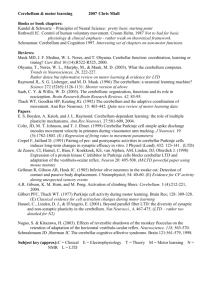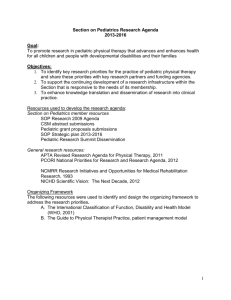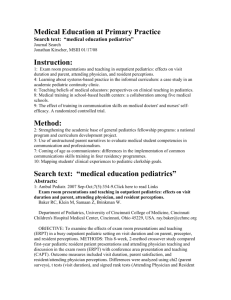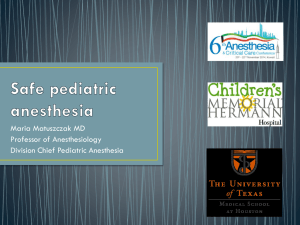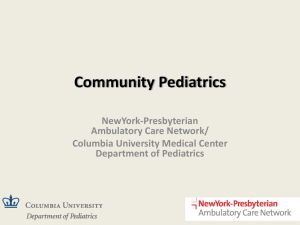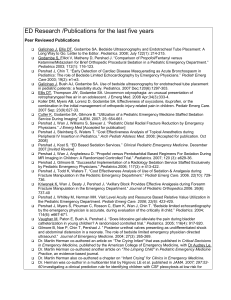PowerPoint - Interactive Metronome
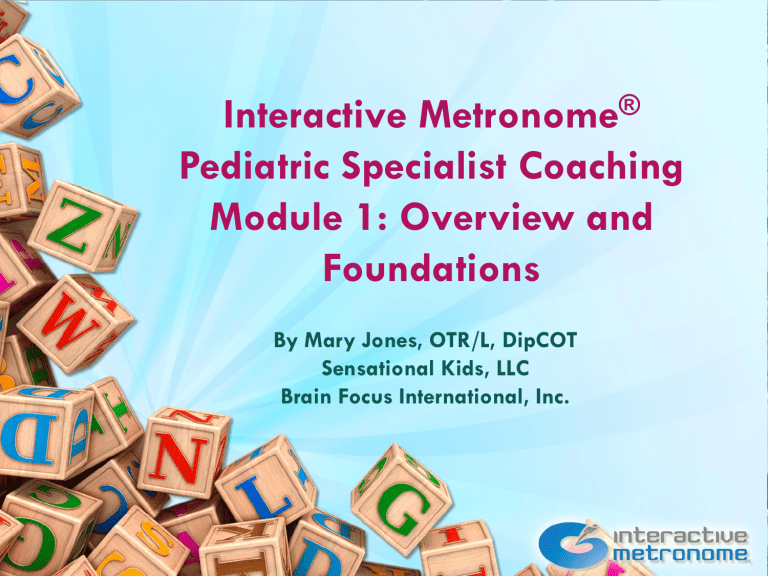
Interactive Metronome
®
Pediatric Specialist Coaching
Module 1: Overview and
Foundations
By Mary Jones, OTR/L, DipCOT
Sensational Kids, LLC
Brain Focus International, Inc.
Program Outline
• Module 1: Pediatric Overview and Foundations
• Module 2: Modifying IM to Pediatric Populations
• Module 3: Motivational Strategies
• Module 4: Teaching Auditory Association Skills
• Module 5: Building relationships – Allowing control, switch choices and access.
• Module 6: Interpreting Data
• Module 7: Setting up Individualized Pediatric Treatment Plans with IM: Case
Examples.
• Module 8: Special Considerations – IM training plans with infant-toddlers or clients with decreased cognitive capabilities.
• Module 9: Use of IM Systems in Group and Social Settings
• Module 10: Moving Forward – Incorporating IM-Home into your pediatric best practices.
Outcome Goals for Module 1
• Developing the art of ‘ thinking outside the box ’ with IM
• Overview of IM use within the diversity of pediatrics
• Getting started – Setting up of equipment/ environments
• The Key to IM success – Learning to Modify!
• Positioning that can be used with IM – Review of Examples
• Review of Module 1 Learning Outcomes.
Thinking ‘ outside of the box ’
• Use of professional judgment and creativity to modify IM programming – we are a diverse group!
• Developing the flexibility skills to effectively utilize IM as a treatment/training tool
• Becoming comfortable thinking ‘ outside of the box ’
• Taking the principles of the Interactive Metronome ®
System and consider them for all aspects of pediatric services and performance programs.
Why IM in Peds?
• Timing is critical for the discrimination of sensory stimuli (Shannon et al., 1995; Buonomano and Karmarkar, 2002; Ivry and Spencer,
2004; Buhusi and Meck, 2005)
• Timing is critical for the generation of coordinated motor responses (Mauk and Ruiz, 1992; Ivry, 1996; Meegan et al., 2000;
Medina et al., 2005).
• The nervous system processes temporal information over a wide range, from microseconds to circadian rhythms (Carr, 1993; Mauk and Buonomano, 2004; Buhusi and Meck, 2005).
Applying IM to the diversity of
Pediatrics
• Educational
• Therapeutic
• Peak Performance
• Recreational
• Extra-curricular
• Lifestyle
• Wellness
Educational
• Low Self Esteem
• Struggling with academics
• Anxiety
• Reactive
• Poor motor planning
• Difficulty finding their own
‘ Rhythm ’ or ‘ Still point ’
• Eager to please
• Difficulty ‘ tuning in ’
• Difficulty keeping track of time
• Survival reactions
• Chronic adrenal stress
• Disorganized
• Clumsy
• Difficulty ‘ connecting the dots ’
• Poor listening skills
• ‘ Quick to quit ’
Therapeutic
• Attention Deficit Disorder (314.0; 314.01)
• Asperger ’ s Syndrome (299.0)
• Ataxia (438.84; 334.3; 331.89)
• Autism (299.0)
• Developmental Delays (315.9)
• Dyspraxia (315.4)
• Dyslexia (315.02)
• Lack of Coordination (781.3)
• Speech and Language delays (315.3)
• Auditory Processing Disorders (388.45;
315.32)
• Unspecified Disorders of the Central
Nervous System (349.9)
• Hemiplegia (342; 343.1)
• Pervasive Developmental Delay (299.9)
• Developmental Coordination Disorder
(315.4)
• Abnormal Posture (781.92)
• Loss of Limb (755.4)
• Abnormality of Gait (781.2)
• Difficulty in Walking (719.7)
• Orthotic Training (V57.41)
• Feeding Difficulties (783.3; 307.59; 779.3;
783.41)
• Dysphagia (787.42)
• Articulation (315.39; 524.27)
• Muscle Weakness (728.87; 780.79)
• Tourette ’ s Disorder (307.23; 333.3)
• Anxiety (300.0)
Peak Performance
• Speed focuses on developing starting speed and maximizing top end speed. Utilization of plyometrics and speed training techniques to maximize performance.
• Agility – focuses on developing coordination, foot speed, reactive ability, and quickness. Utilization of sport specific movement pattern drills, plyometrics, and various mobility training equipment.
• Conditioning – focuses on developing sport specific fitness by combining creative training methods with traditional conditioning equipment.
• Strength – focuses on teaching proper resistance training techniques for a variety of sport specific exercises with emphasis on core.
Recreational
• Effective use of free time
• Personal development of ‘ self ’
• Socially acceptable activities
• PLAY!
• Keeping up with peers
• Ability to engage, socialize, plan, follow-through
• Choices
• Opportunities
• Exposure
• Tolerance
Lifestyle
• Sports
• Drama
• Music
• Voice
• Dance
• Clubs
• Societies
• Cultural
Extra-Curricular
Wellness
• Mental Endurance
• Mental Attitude
• Stress Management
• Focused Attention
• Sleep
The Key to IM Success:
• Modify for Engagement!
• Be Spontaneous for Novelty!
• Increase Repetition for
Synaptic Growth!
Techniques for success
• Positioning alternatives
• Physical Environment
• Sensory Environment
• Motivation Strategies
• Tempo/Timing variance
• Feedback Strategies
• Interpreting Data
• Pacing of activities and themes
• Duration of tasks and sessions
• Building Relationships – allowing control
• Switch choices and Access
Set Up - Equipment
Positioning: Upright Stance
UPRIGHT STANCE: Extensor tone; balance; visual orientation; praxis.
• Modify with variance of surface/texture/height/size of base/footwear.
Half Kneeling
HALF KNEELING
• Core strengthening
• Pelvic segmentation
• Upper body/lower body integration
• Proprioceptive body-in-space awareness
• Reflex integration
• Bilateral integration (praxis)
MODIFY:
• Surfaces/textures/heights/ stability/alternate knees
Modify Base of Support
• Alter points of stability and mobility
• Upper extremities: Clap High-Clap Low
• Adapt lower extremity movement sequence
• Side step and clap on the beat
• Match tempo of music piece or sing to the beat
Round Sitting
ROUND SITTING :
• Pelvic and shoulder girdle alignment
• Posture and positional awareness (grounded)
• Upper body strengthening
• Pelvic shift and core balance
• Diaphragmatic breathing
Dynamic Postures
DYNAMIC POSTURES:
• Proprioceptive awareness
• Core stability and shift
• Visual orientation
• Strengthening
• Praxis
EXAMPLES:
• Ball sit
• Stool sit
• Bench sit
• Bolster sit (astride)
• Cube sit
• Rocking chair
Supine/Lying Down
SUPINE TIME:
• Facilitates proprioceptive awareness
(firm surface)
• Decreases demands on motor planning
• Work up against gravity
• Reflex integration: Supine flexion
Modifications:
• Floor (good for sensory feedback
• Floor mat/different textures
• Inverted/under/over
Prone/Tummy Time
PRONE/TUMMY TIME:
• Strengthening shoulder girdle
• Hip flexor stretch
• Facilitate co-contraction to flexor/extensor core stability
• Visual-motor integration
• Reflex integration
Review of Module 1 Learning
Objectives
• IM is used as a training tool across multiple domains and disciplines within pediatrics.
• Professional judgment and creativity are required to provide optimum outcomes in pediatric IM programs.
• Modification is key to provide a customized approach to each individual.
• Pediatrics is diverse – so too is the application of IM to this population!
Module 1 Homework
1. Complete Module 1 Post-Test
2. Complete Module 1 Worksheet
3. Review ready reference/resource sheet for Module 1
References
• Boyle CA, Boulet S, Schieve L, Cohen RA, Blumberg SJ, Yeargin-Allsopp
M, Visser S, Kogan MD. Trends in the Prevalence of Developmental
Disabilities in US Children, 1997–2008. Pediatrics. 2011
• Buhusi, C.V., and Meck, W.H. (2005). What makes us tick? Functional and neural mechanisms of interval timing. Nat. Rev. Neurosci. 6, 755–
765.
• Buonomano, D.V., and Karmarkar, U.R. (2002). How do we tell time?
Neuroscientist 8, 42–51
• Carr, C.E. (1993). Processing of temporal information in the brain.Annu. Rev. Neurosci. 16, 223–243.
References 2
• Ivry, R. (1996). The representation of temporal information in perception and motor control. Curr. Opin. Neurobiol. 6, 851–
857
• Ivry, R.B., and Spencer, R.M.C. (2004). The neural representation of time. Curr. Opin. Neurobiol. 14, 225–232
• Mauk, M.D., and Buonomano, D.V. (2004). The neural basis of temporal processing. Annu. Rev. Neurosci. 27, 304–340
• Mauk, M.D., and Ruiz, B.P. (1992). Learning-dependent timing of Pavlovian eyelid responses: differential conditioning using multiple interstimulus intervals. Behav. Neurosci. 106, 666–681
References 3
• Medina, J.F., Carey, M.R., and Lisberger, S.G. (2005). The representation of time for motor learning. Neuron 45,
157–167.
• Meegan, D.V., Aslin, R.N., and Jacobs, R.A. (2000). Motor timinglearned without motor training. Nat. Neurosci. 3,
860–862.
• Shannon, R.V., Zeng, F.G., Kamath, V., Wygonski, J., and
Ekelid, M. (1995). Speech recognition with primarily temporal cues. Science 270, 303–304.
Useful Resources
Sensory Processing Disorder:
• www.spdfoundation.net
• www.sensory-processingdisorder.com
• www.sensorysmarts.com
• www.spdsupport.org
Dyspraxia:
• www.dyspraxiausa.org
• www.dyspraxia.info
• www.alifewithdyspraxia.
webs.com
Autism:
• www.autismspeaks.org
• www.aspergersyndrome.
org
• www.autismspot.org


